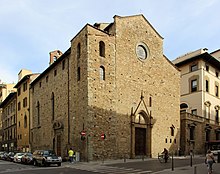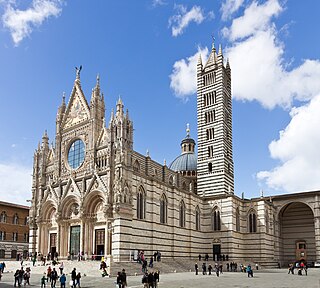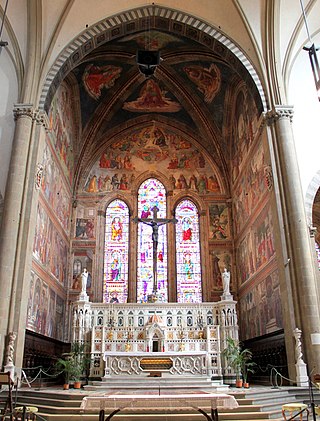

Santa Maria Maggiore di Firenze is a Romanesque and Gothic-style, Roman Catholic church in Florence, region of Tuscany, Italy. This is among the oldest extant churches in Florence.


Santa Maria Maggiore di Firenze is a Romanesque and Gothic-style, Roman Catholic church in Florence, region of Tuscany, Italy. This is among the oldest extant churches in Florence.
The church was originally constructed in the 11th century and underwent extensive renovations to the facade and sides in the 13th century.
The original church existed as early as the 8th century, and is first documented in 931. The legend assigning its foundation to Pope Pelagius II in 580 A.D. is not reliable.

In 1176 it obtained the status of collegiate church and was one of Florence's priories. The church subsequently expanded its possessions and in 1183 it was put under papal direct protection by Lucius III in 1186, which it kept in the following century. Acquired by the Cistercians, in the 13th century the church was rebuilt (with the exception of the original external walls and the vaults) in Gothic style. Giorgio Vasari mentions one "Master Buono" as the designer of the new edifice; he also writes that the high altar had a Coronation of the Virgin by Agnolo Gaddi, and the Cappella Maggiore contained frescoes by Spinello Aretino with the Stories of the Virgin and St. Antony Abbot, of which today only a fragment survives.
During the 15th century the church's finances declined: in 1514 Giulio de' Medici describes it as decaying, and in the following year the pope gave it to the Florence Cathedral's capitol. In 1521 it went to the Carmelites from Mantua. In the early 17th century the interior was restored by Gherardo Silvani, perhaps following a project by Bernardo Buontalenti.
The exterior is rather undecorated, with stone walls and the portals surmounted by tympani. The bell tower, although reduced in height, survives from the Romanesque building. It has a Roman head embedded in its walls, popularly known as Berta
The interior is simple with a nave and two aisles, ogival arches and groin vaults. [1] Artworks include frescoes by Bernardino Poccetti (Histories of St. Zenobius in the vault), a Nativity by Matteo Rosselli, and, above the altar of the left transept chapel, a polychromed stucco relief panel, the Madonna del Carmelo, long attributed to the 13th century artist, Coppo di Marcovaldo. A recent restoration has caused scholars to question this attribution and posit an earlier, 12th century date for the panel. [2] The same chapel houses the tomb of Brunetto Latini, discovered in 1751, and a sarcophagus attributed to Tino di Camaino (early 14th century).
Other artworks once housed in the church include the Carnesecchi Triptych, by Masolino da Panicale and Masaccio, as well as the Martyrdom of St. Sebastian and the Lamentation over the Dead Christ with Saints by Botticelli.

Arezzo is a city and comune in Italy and the capital of the province of the same name located in Tuscany. Arezzo is about 80 kilometres southeast of Florence at an elevation of 296 metres (971 ft) above sea level. As of 2022, the population was about 97,000.

Santa Maria Novella is a church in Florence, Italy, situated opposite, and lending its name to, the city's main railway station. Chronologically, it is the first great basilica in Florence, and is the city's principal Dominican church.

Siena Cathedral is a medieval church in Siena, Italy, dedicated from its earliest days as a Roman Catholic Marian church, and now dedicated to the Assumption of Mary.

Pinturicchio, or Pintoricchio, also known as Benetto di Biagio or Sordicchio, was an Italian painter during the Renaissance. He acquired his nickname because of his small stature and he used it to sign some of his artworks that were created during the fifteenth and sixteenth centuries.

Alatri is an Italian town and comune of the province of Frosinone in the region of Lazio, with c. 30,000 inhabitants. An ancient city of the Hernici, it is known for its megalithic acropolis.

The Basilica of Saint Francis of Assisi is the mother church of the Roman Catholic Order of Friars Minor Conventual in Assisi, a town in the Umbria region in central Italy, where Saint Francis was born and died. It is a papal minor basilica and one of the most important places of Christian pilgrimage in Italy. With its accompanying friary, Sacro Convento, the basilica is a distinctive landmark to those approaching Assisi. It has been a UNESCO World Heritage Site since 2000.

Santa Maria dei Miracoli and Santa Maria di Montesanto are two churches in Rome.

The Cathedral of St. Anastasia is the Roman Catholic cathedral of Zadar, Croatia, seat of the Archdiocese of Zadar, and the largest church in all of Dalmatia.

Prato Cathedral, or Cathedral of Saint Stephen, is a Roman Catholic cathedral in Prato, Tuscany, Central Italy, from 1954 the seat of the Bishop of Prato, having been previously, from 1653, a cathedral in the Diocese of Pistoia and Prato. It is dedicated to Saint Stephen, the first Christian martyr.


Santa Maria del Carmine is a church of the Carmelite Order, in the Oltrarno district of Florence, in Tuscany, Italy. It is famous as the location of the Brancacci Chapel housing outstanding Renaissance frescoes by Masaccio and Masolino da Panicale, later finished by Filippino Lippi.

The Tornabuoni Chapel is the main chapel in the church of Santa Maria Novella, Florence, Italy. It is famous for the extensive and well-preserved fresco cycle on its walls, one of the most complete in the city, which was created by Domenico Ghirlandaio and his workshop between 1485 and 1490.

The Abbey of Monte Oliveto Maggiore is a large Benedictine monastery in the Italian region of Tuscany, 10 km south of Asciano. Its buildings, which are mostly of red brick, are conspicuous against the grey clayey and sandy soil—the Crete senesi which give this area of Tuscany its name.


Santa Maria delle Vigne is a Roman Catholic basilica church in Genoa, Italy. It was built in the 10th century. The main altar was completed in 1730 by Giacomo Antonio Ponsonelli. The church is also the final resting place of the leading early Italian composer Alessandro Stradella, who was murdered in 1682.


Santa Maria Maggiore is a church in Alatri, Latium, central Italy. It was founded in the 5th century, over the ruins of an ancient temple dedicated to Venus, although it was mentioned for the first time in 1137. It was later renovated in Romanesque style and received further Gothic additions during the 13th century.

San Giovanni in Monte is a 15th-century Roman Catholic church in Bologna, Italy.

Santa Maria Maggiore is an ancient Romanesque basilica church located at the foot of Colle di San Pietro in Tuscania, Province of Viterbo, Region of Lazio, Italy. Atop the hill is the Basilica of San Pietro.

San Francesco is a Romanesque- and Gothic-style Roman Catholic church located in the center of Lucignano, region of Tuscany, Italy.